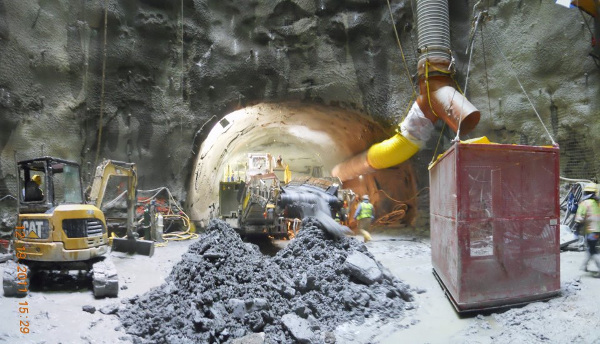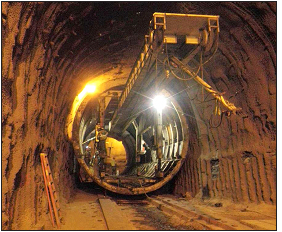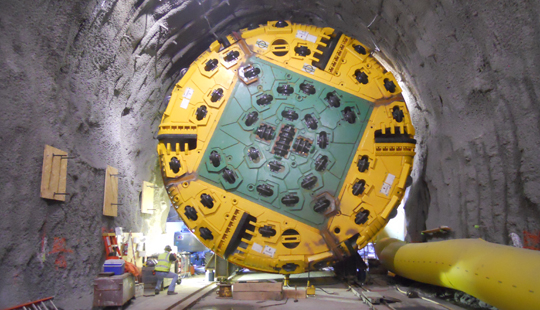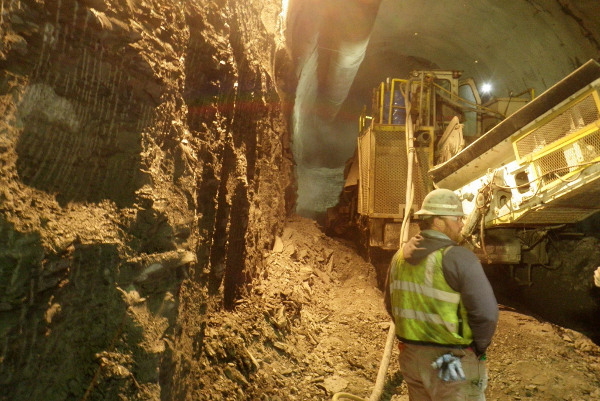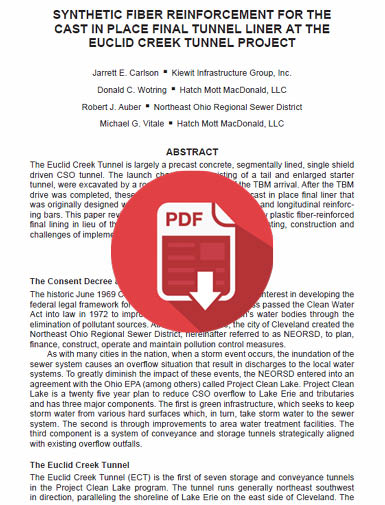Euclid Creek Starter and Exit Tunnels Reinforced with Barchip Synthetic Fiber
Cast In-Situ Lining of the Euclid Creek Starter and Exit Tunnels Reinforced with Barchip’s Synthetic Fiber Concrete Reinforcement.
Owner: NEORSD
General Contractor: McNally-Kiewit ECT
Joint Venture Contractor & Owner Engineer: Hatch Mott MacDonald (HMM)
The Euclid Creek Storage Tunnel (ECT) Project forms a major component of the Northeast Ohio Regional Sewer District’s (NEORSD) Project Clean Lake Program and is the first of seven storage and conveyance tunnels in the program. The 3.4 mile, 24-foot diameter ECT is largely a precast concrete, segmentally lined, single shield driven CSO tunnel.
A 300-foot long tail tunnel running in the opposite direction to ECT was required to provide a future connection to the 2nd phase Dugway Storage Tunnel. A 125-foot long, 30 foot diameter starter tunnel was constructed as the TBM launching chamber. At completion of the TBM drive these tunnels required a cast in place final liner originally designed with a single layer of steel bar, which was later changed to Barchip’s synthetic fiber reinforcement.
Design Change
The design comprised a rock load of 2,240 psf and external hydrostatic water pressure equivalent at ground surface, or 12,600 psf. The final design of the cast in place lining was determined to be a minimum 16 in. thick 6,000 psi compressive strength concrete lining reinforced with an inner mat of steel bars. The reinforcement selected was no. 8 bars on 12 in. centre to centre spacing each way. To reduce costs and shorten the schedule the contractor requested a change order be considered to replace the single layer of reinforcing steel with synthetic fiber reinforcement.
- The benefits of using synthetic fibers as perceived by the project team included the following:
- Eliminate the need to detail, fabricate, deliver, handle, place and tie reinforcing steel.
- Separate operation of moving gantry to place and tie rebar not needed.
- Simplify the wood bulkheads at end of forms – no penetrations.
- Reduce the labour hours thereby reducing risk of injury due to exposure.
- Reduce risk of injury by eliminating the need for labourers to be placed in awkward positions to place and tie reinforcing steel from a gantry.
- Reduce pumping issues with synthetic fibers over steel fibers.
- Improve long term durability and quality as there are no deteriorating effects from the oxidation of reinforcing steel.
[et_bloom_inline optin_id=”optin_4″]
Fiber Selection
Extensive plastic fiber testing was performed by Madsen et al 2009 for the Devil’s Slide road tunnel. Based on these published results, the contractor initially selected the same synthetic fibers for the ECT Tail and Starter tunnels. The results of these tests were confirmed by trials on-site using 11.8 lbs/cy of synthetic. Barchip’s synthetic fiber was the highest performing fiber in both trials and was subsequently specified for ECT.
Concrete Mix
Site trials were undertaken in October 2013 using a combination of mix variables. After testing at a local laboratory and The University of Michigan the following criteria were determined.
- f’c ≥ 6,000 psi
- F1 ≥ 500 psi (first crack flexural strength)
- F300, 1.5 ≥ 350 psi (residual flexural strength at deflection L/300)
- Air content between 5%–7%
- Slump 4-inch target
Construction
Placement operations began in March 2014. Forms utilized were 24-foot diameter full circle telescoping forms, equipped with a form carrier and needle beam. The carrier could handle 32-foot long sections of formwork, and the contractor chose to use two sections of formwork for the cycle, making a 64 foot long pour.
600 to 900 cubic yards were required for each pour, delivered over 600 foot with a Putzmeister 36Z pump truck with a 16H 9-inch piston pump.
The first pour day had to be stopped early as a result of concrete build up at the hopper grate. The one way bar grate was increased from 2.5 to 5 in. The second and all subsequent pour days went fine with typical line pressures of 70 to 90 bar.
Test samples were taken from 7 concrete placements. All the test results passed both first crack and residual strength requirements.
The Barchip synthetic fiber reinforced cast in place lining was considered a success by the project team, who plan to implement the solution on future projects.

